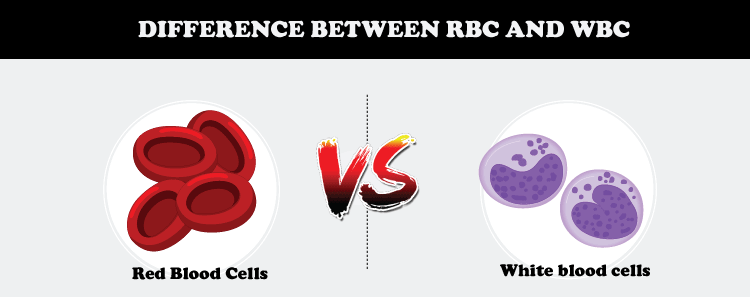Difference between RBC and WBCVarious types of cells are present in our body, and every cell has different functioning and work. Notably, it is believed that there are more than 200 types of cells present in the human body. Notable examples of cells include red blood cells (erythrocytes), skin cells, neurons (nerve cells), and fat cells. This article mainly discusses the RBC (Red Blood Cells) and WBC (White Blood Cells) and the major differences based on their various roles and functions. 
What is the importance of cells in our body?Each cell type is specialized to perform a specific function and is essential for maintaining overall health and well-being. The importance of cells in our body is immense, and here are some major reasons that demonstrate the essential role of cells: Structure Cells provide the structural framework for all tissues and organs in the body. They come in different shapes and sizes and can be organized into various tissues, such as muscle, nerve, and connective tissue. Function Each cell type in the body is specialized to perform a specific function. For example, red blood cells carry oxygen, while white blood cells help fight infections. Skin cells protect the body from external threats, and nerve cells transmit signals. Repair and Regeneration To regenerate and repair damaged tissues, cells are essential. Stem cells can develop into diverse cell types, supporting tissue and organ regeneration. Metabolism Cells carry out all metabolic processes necessary to maintain life. This includes converting food into energy, eliminating waste products, and regulating the body's internal environment. Communication Cells communicate with one another through various pathways to coordinate their functions and maintain overall homeostasis in the body. In summary, cells are essential for the structure, function, repair, and regeneration of all tissues and organs in the body. What are Red Blood Cells?Red blood cells, also known as erythrocytes, are a distinct type of cell found in the blood. They are responsible for carrying oxygen from the lungs to the rest of the body and transporting carbon dioxide from its tissues back to the lungs, where it can be exhaled. Red blood cells are flexible and can change shape as they pass through narrow blood vessels, allowing them to move through the circulatory system and deliver oxygen to all body parts. They have a lifespan of about 120 days before they are broken down and recycled by the body. Too many red blood cells can lead to polycythemia, increasing the risk of blood clots and other health problems. We can quickly check the health of our red blood cells with the help of a blood test. Role of Nutrition in Red Blood CellsYou can maintain healthy red blood cells by eating foods high in iron. Red blood cells require vitamins to grow and remain healthy. These include the B-2, B-12, and B-3 vitamins, which are present in foods like eggs, whole grains, and bananas. Moreover, folate is also beneficial. It may be found in orange juice, green leafy vegetables, dry beans, lentils, and fortified cereals. What are White blood cells?White blood cells, also known as leukocytes, are a crucial part of the immune system and play an essential role in protecting the body against infections and other foreign invaders. Different white blood cells exist in our body with unique functions. Some notable types of WBC include the following: Neutrophils Neutrophils are the most common type of white blood cell and are often the first cells to respond to an infection. Lymphocytes Lymphocytes are white blood cells that are essential to the immune system. There are two main types of lymphocytes: B cells and T cells. B cells produce antibodies that target specific pathogens, while T cells help to destroy infected cells and regulate the immune response. Basophils Basophils are a type of white blood cell involved in the inflammatory response. Each type of white blood cell plays a specific role in the immune response and works together to protect the body against infections and other foreign invaders. Types of white blood cells, each with Role of WBC in BodyIn addition to fighting infections, white blood cells also play a role in other immune responses, such as allergies and autoimmune diseases. In allergies, white blood cells overreact to harmless substances, such as pollen or pet dander, and trigger an inflammatory response. A healthy level of white blood cells is essential for overall health and well-being. Too few white blood cells can lead to a weakened immune system and an increased risk of infection, while too many white blood cells can be a sign of an underlying medical condition, such as leukaemia. WBC is essential for the overall body and immune system. They come in several different types, each with its unique function, and work together to mount an immune response when the body is exposed to a pathogen. A healthy level of white blood cells is essential for overall health and well-being, and a healthcare professional should always be proactive and evaluate any abnormalities. RBC vs. WBC
Here is the table which highlights the major differences between RBC and WBC side by side:
Next TopicDifference Between
|
 For Videos Join Our Youtube Channel: Join Now
For Videos Join Our Youtube Channel: Join Now
Feedback
- Send your Feedback to [email protected]
Help Others, Please Share










